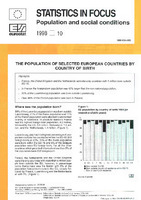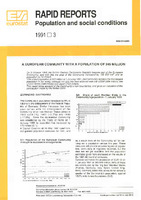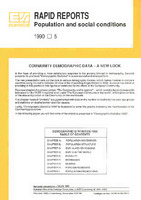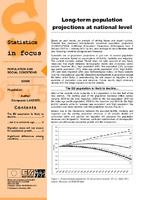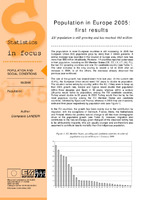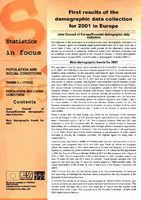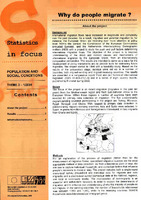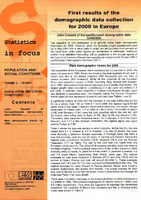Αναζήτηση
Αποτελέσματα 1-10 από 21
Statistics in Focus: Population and social conditions. THE POPULATION OF SELECTED EUROPEAN COUNTRIES BY COUNTRY OF BIRTH. 1998
(Statistical Office of the European Communities and Social Statistics, 1998)
Highlights . France, the United Kingdom and the Netherlands were the only countries with 1 million born outside EU-15. . In France the foreign-born population was 42% larger that the non-national population. . 30% of the ...
RAPID REPORTS Population and social conditions. A EUROPEAN COMMUNITY WITH A POPULATION OF 345 MILLION.
(Statistical Office of the European Communities and Social Statistics, 1991)
On 3 October 1990, the former German Democratic Republic became part of the European Community, and with this the area of the Community increased by 108 000 krrr and its population by 16 million. With a total population ...
RAPID REPORTS Population and social conditions. COMMUNITY DEMOGRAPHIC DATA - A NEW LOOK.
(Statistical Office of the European Communities and Social Statistics, 1990)
In the hope of providing a more satisfactory response to the growing interest in demography, Eurostat presents its yearbook "Demographic Statìstica' in a new revised and enlarged form. The new presentation ...
Statistics in Focus: Population and social conditions. Long-term population projections at national level.
(Statistical Office of the European Communities and Social Statistics, 2006)
Based on past trends, an analysis of driving forces and expert opinion, Eurostat has produced internationally consistent population projections (EUROPOP2004: EUROstat POpulation Projections ...
Statistics in Focus: Population and social conditions. Population in Europe 2005: first results
(Statistical Office of the European Communities and Social Statistics, 2006)
The population in most European countries is still increasing. In 2005 the European Union (EU) population grew by more than 2 million persons. A similar increase was recorded in the Council of Europe ...
Statistics in Focus: Population and social conditions. First results of the demographic data collection for 1997 in Europe.
(Statistical Office of the European Communities and Social Statistics, 1998)
The population of most countries in Europe grew slightly in 1997, though there continued to be some decreases in certain central and eastern European countries. The population of the countries of the European Union grew ...
Statistics in Focus: Population and social conditions. First results of the demographic data collection for 1999 in Europe.
(Statistical Office of the European Communities and Social Statistics, 2000)
This is the third publication from the joint data collection exercise carried out by the Council of Europe and Eurostat. The country coverage is included in the tables and in the Glossary on the following ...
Statistics in Focus: Population and social conditions. First results of the demographic data collection for 2001 in Europe.
(Statistical Office of the European Communities and Social Statistics, 2001)
The objective of this publication is to provide some basic demographic information for 2001. However, given the timetable (rapid questionnaire sent out in April 2002 with a return date of May), not all countries could ...
Statistics in Focus: Population and social conditions. Why do people migrate?
(Statistical Office of the European Communities and Social Statistics, 2001)
International migration flows have increased in magnitude and complexity over the past decades. As a result, migration and potential migration to, for instance, the European Union are receiving ...
Statistics in Focus: Population and social conditions. First results of the demographic data collection for 2000 in Europe.
(Statistical Office of the European Communities and Social Statistics, 2001)
The objective of this publication is to provide some basic demographic information for 2000. However, given the timetable (rapid questionnaire sent out in May 2001 with a return date ...

